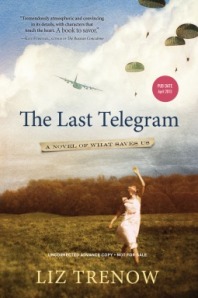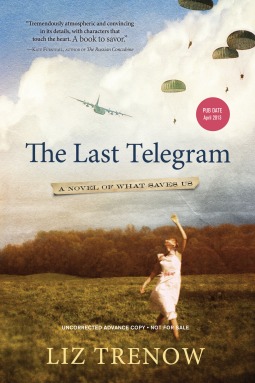 I mentioned earlier this week, in my post Saltaire, Lyon and weavers’ stories, that I’d downloaded Liz Trenow’s The Last Telegram, a romance in which the silk industry plays an integral role. The novel has been waiting patiently for me to pick it up, and now I’ve finished it – and thoroughly enjoyed it :)
I mentioned earlier this week, in my post Saltaire, Lyon and weavers’ stories, that I’d downloaded Liz Trenow’s The Last Telegram, a romance in which the silk industry plays an integral role. The novel has been waiting patiently for me to pick it up, and now I’ve finished it – and thoroughly enjoyed it :)
The story of The Last Telegram begins just before the outbreak of World War Two. I’m always curious to read a novel featuring silk-weaving, since my own novel, The Silk Romance, is set in a silk-weaving mill in Lyon. Liz Trenow’s novel is set in a silk mill in East Anglia, and I was looking forwad to discovering more about silk’s history in England.
My novel, The Silk Romance, is a category romance, which means the main focus of the story is on the romantic relationship between the heroine, Sophie, and her French hero, Jean-Luc. Liz Trenow’s The Last Telegram is a longer novel, with room to go into far more detail about the manufacturing process, and this was the element of the book which I found most fascinating.
You may have heard me mention before that I worked in manufacturing for a number of years, including in a woollen mill in Yorkshire. It was fascinating to hear the experiences at Liz Trenow’s fictional Verners Mill, and it’s a tribute to the author that so much of it struck a chord.
When the story starts, the heroine, Lily Verner, is just about to begin a reluctant apprenticeship in her father’s mill. She is supposed to be at college in Switzerland, but her dad says she can’t go, because he’s worried about the possiblity of war. The teenage Lily is a bit peeved at this, to say the least. She could be in Europe, having a whirl. Instead, she has to put on an unattractive set of overalls and work in a noisy and overheated weaving shed.
Within a matter of days, though, she has grown to realise there’s far more to the industry than standing in a dusty shed, trying to lip read above the racket. Silk-weaving is a fascinating trade, and Liz Trenow has researched it thoroughly. As Lily follows her apprenticeship, we learn with her, from the production of the yarn, to the dyeing, to the design and make-up of the various gorgeous silks, and the weaving and finishing.
When war breaks out, Verners mill moves over to the production of silk for parachutes. The pressure is on to keep up with the demand, and there was so much here that resonated with me from my own time working in the high-pressure environment of a factory. Customers place orders which are urgent; if the orders are accepted, it’s up to the production team to try and fulfil them. Verners mill manager, Gwen,comes under pressure to produce twenty rolls of quality silk by an impossibly tight deadline. Understandably she is really stressed by this, but she knows it has to be done. When she utters the words, “With a bit of luck and a following wind…” , I had a little chuckle to myself. Interesting to know that works managers today still come out with the same phrases, afer sixty years :)
In fact the whole order process was depicted so realistically, I began to feel quite stressed myself! Silk-weaving is merely the backdrop to my own novel, and not an integral part of the story. I still made sure to put in an exchange between the hero, Jean-Luc, and the weaving supervisor, Irina, regarding an order for some lengths of silk, which are urgently required to refurbish an opera house. I wanted to give readers an idea of the pressure of the environment.
As for the other aspects of The Last Telegram, I also enjoyed the romance between Lily and a young Jewish refugee, Stefan. The plight of the Jewish refugees was well-researched, including the fact that some of them were interned and sent to Australia, which I didn’t know before. The depiction of the aftermath of the Blitz in London was also very realistic. Verner’s head office in London gets bombed, and the firm loses some irreplaceable documents. Again, this struck a chord with me. My Irish grandfather worked at a manufacturer’s in Manchester during the war. His offices were bombed, but my granddad was able to recreate all the customer’s details from memory. His fantastic feat of recall, which made a massive difference to the factory, made an article in a Manchester newspaper, and the cutting is still in the family.
If you are interested in the historical background to this story, and in the process of weaving, then I can highly recommend Liz Trenow’s The Last Telegram. For me, it was a fascinating read.
In the meantime, The Silk Romance will be published 24th May 2013 (a week today – yay!), and is now available here in the publisher’s bookstore.
Did you enjoy my review? Have you read any novels which feature the textile industry, or which gave you an insight into any other trade? If you have any book recommendations, or any comments at all, please let me know – I always love to hear from you!


Leave a Reply